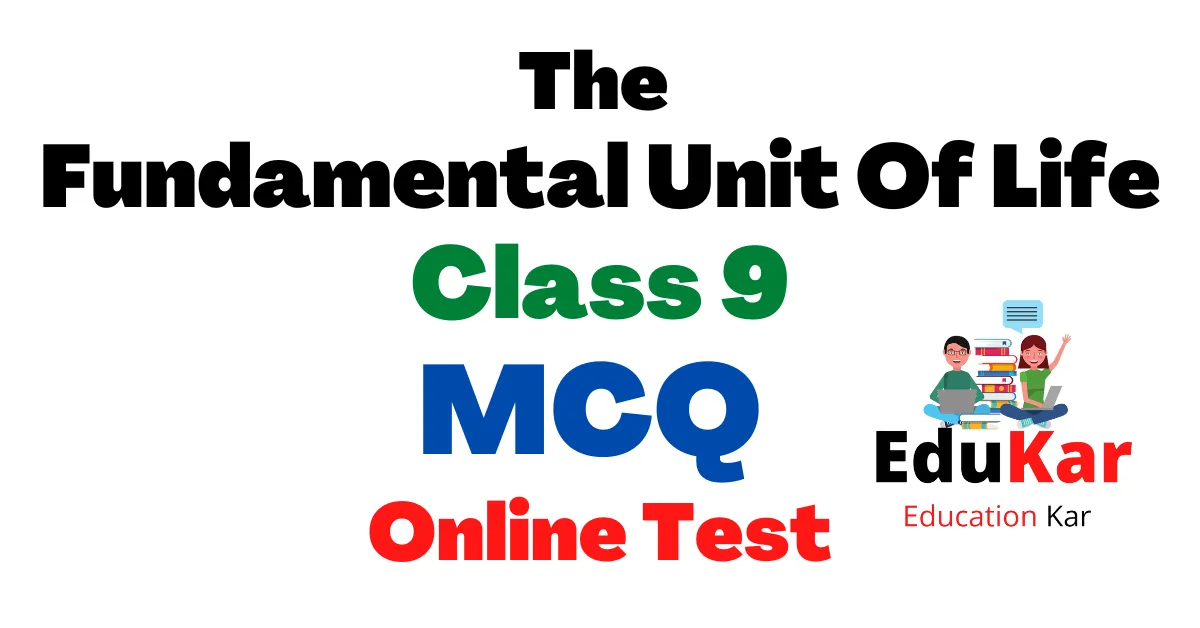
1) Chromosomes are built of
(a) DNA & protein
(b) RNA
(c) DNA
(d) Protein
Answer- a
2) Plasmolysis in a plant cell is explained as
(a) shrinkage of cytoplasm in hypertonic medium
(b) breakdown (lysis) of plasma membrane in hypotonie medium
(c) shrinkage of nucleoplasm
(d) none of them
Answer- b
3) Which cell organelle plays a significant role in detoxifring various poisons & drugs in a cell?
(a) Smooth endoplasmic reticulum
(b) Lysosomes
(c) Golgi apparatus
(d) Vacuoles
Answer- a
4) The undefined nuclear region of prokaryotes is also called as
(a) nucleus
(b) nucleic acid
(c) nucleoid
(d) nucleolus
Answer- c
5) Which out of the below is not a function of vacuole?
(a) Locomotion
(b) Storage
(c) Waste excretion
(d) Providing turgidity and rigidity to the cell
Answer- a
6) Cell wall of which one of these is not built of cellulose?
(a) Hydrilla
(b) Mango tree
(c) Cactus
(d) Bacteria
Answer- d
6) Organelle other than nucleus, carrying DNA is
(a) mitochondria
(b) lysosomes
(c) golgi apparatus
(d) endoplasmic reticulum
Answer- a
7) Lipid molecules in the cell are intermixed by
(a) golgi apparatus
(b) plastids
(c) rough endoplasmic reticulum
(d) smooth endoplasmic reticulum
Answer- d
8) Which plastids are white?
(a) Leucoplasts
(b) Chromoplasts
(c) Chloroplast
(d) All of the above
Answer- a
9) ________ is known as the energy currency of the cell
(a) Mitochondria
(b) ATP
(c) Oxygen
(d) Endoplasmic reticulum
Answer- b
10) Which of the below is not a function of the vacuole in plants?
(a) They help with the process of cell division
(b) They help to maintain turgidity
(c) They provide structural support
(d) They store toxic metabolic wastes
Answer- a
11) The method by which water passes through a semi-permeable barrier from an area of high concentration to an area of lower concentration, balancing the concentration of water, is known as:
(a) Diffusion
(b) Osmosis
(c) Evaporation
(d) All of the above
Answer- b
12) Which of the below can be made into crystal?
(a) A virus
(b) An Amoeba
(c) A bacterium
(d) A sperm
Answer- a
13) Kitchen of the cell is known as
(a) chioroplast
(b) endoplasmic reticulum
(c) mitochondria
(d) golgi apparatus
Answer- a
14) Silver nitrate solution is used to read or study about
(a) nucleus
(b) endoplasmic reticulum
(c) mitochondria
(d) golgi apparatus
Answer- d
15) Cell stand up from pre-existing cell was stated by
(a) Virchow
(b) Schleiden
(c) Haeckel
(d) Hooke
Answer- a
16) The only vesicles seen in prokaryotic cell is
(a) lysosomes
(b) plastids
(c) ribosomes
(d) mitochondria
Answer- c
17) How much is 1 μm:
(a) 10-10 m
(b) 10-6 m
(c) 10-3 m
(d) 10-9 m
Answer- b
18) Living cells were found by
(a) Leeuwenhoek
(b) Robert Brown
(c) Purkinje
(d) Robert Hooke
Answer- a
19) Lysosome stand up from
(a) mitochondria
(b) endoplasmic reticulum
(c) nucleus
(d) golgi apparatus
Answer- d
20) Vacuoles given for:
(a) Shape
(b) Rigidity
(c) Both (a) and (b)
(d) Turgidity
Answer- d
21) Find the same feature of mitochondria and plastids?
(a) Presence of DNA and ribosomes
(b) Deeply folded inner membrane
(c) Ability to produce ATP
(d) Presence of matrix called stroma
Answer- a
22) Gaseous interchange in cells takes place by:
(a) Endocytosis
(b) Osmosis
(c) Exocytosis
(d) Diffusion
Answer- d
23) A cell organelle that is not covered by a membrane is the ______.
(a) endoplasmic reticulum
(b) Golgi apparatus
(c) ribosome
(d) chloroplast
Answer- c
24) A cover slip is situated over the specimen to
(a) crush the cells in order to see the organelles clearly
(b) remove extra stain and water
(c) prevent the tissue from drying
(d) prevent glycerine from leaking out
Answer- a
25) While seeing a human cheek cell, below a microscope, what students will not see
(a) Mitochondria
(b) Nucleus
(c) Chloroplast
(d) Nucleolus
Answer- d
26) Cell theory states that cells are functional & structural unit of:
(a) animals
(b) plants
(c) microbes
(d) both (a) & (b)
Answer- d
27) Cell walls are usually absent in
(a) Mycoplasma
(b) Bacteria
(c) Plants
(d) Fungi
Answer- a
28) Human body is mainly originated from….
(a) Stomach of mother
(b) single cell
(c) father
(d) None of the above
Answer- b
29) _______ is a complicated substance & gives structural strength in plants
(a) Lipids
(b) Carbohydrates
(c) Cellulose
(d) Minerals
Answer- c
30) _________ give permission to entry & exit of some material in and out of the cell
(a) Cell cover
(b) Cell protector
(c) Cell envelope
(d) Cell membrane
Answer- d





